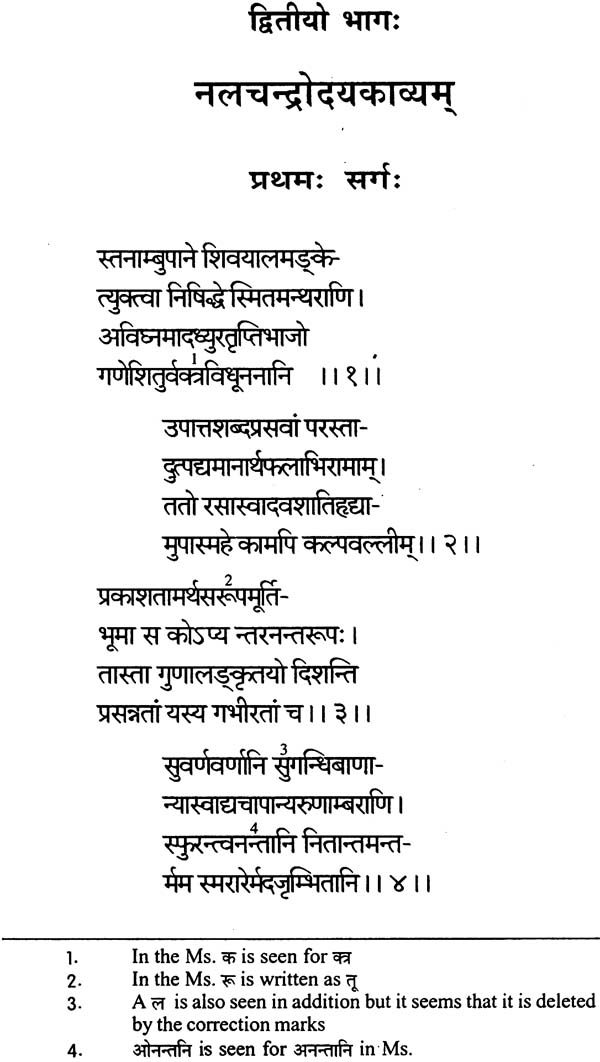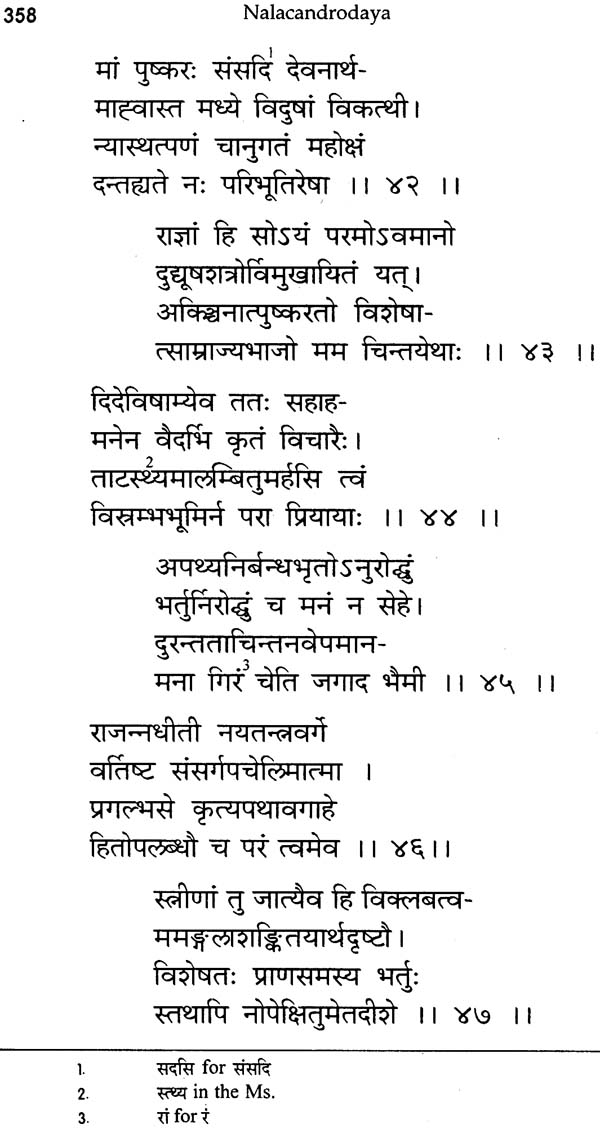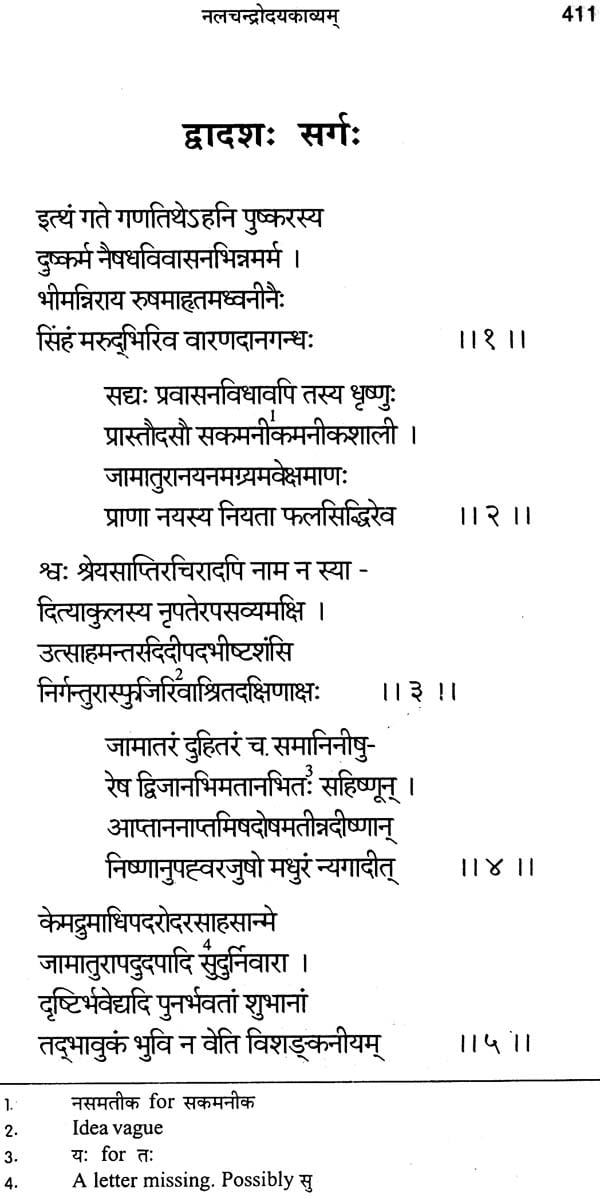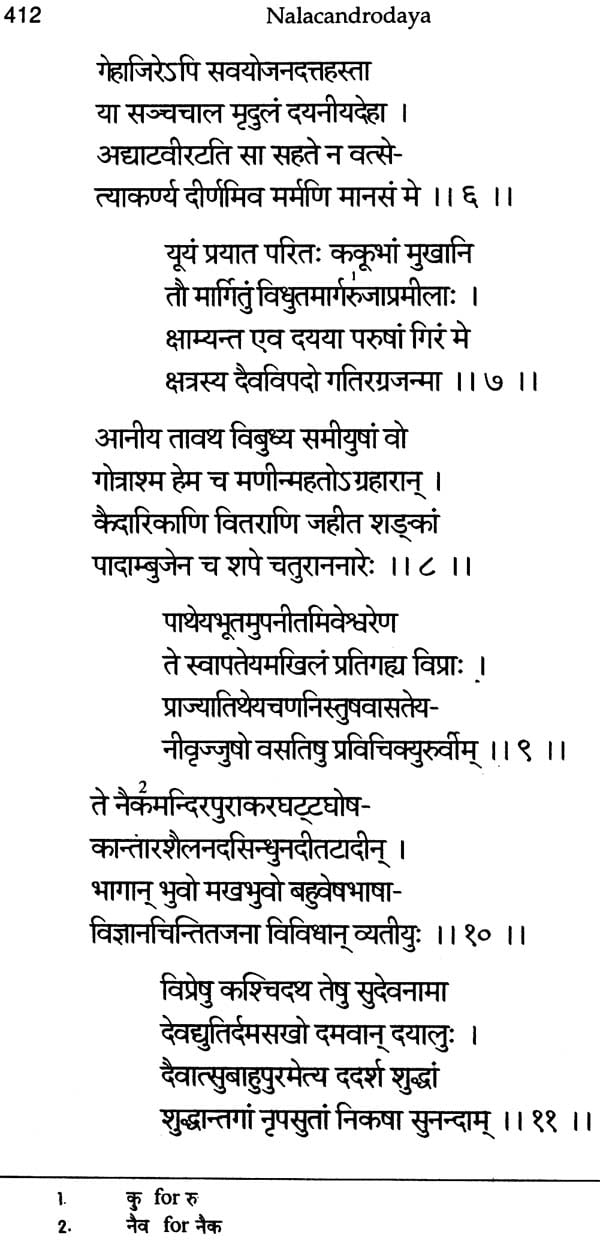
Nalacandrodaya: A Critical Study and Edition (Calicut University Sanskrit Series 28)
Book Specification
| Item Code: | NAI041 |
| Author: | Dr. P. Mohammed Abdul Rahiman |
| Publisher: | Publications Division University of Calicut |
| Language: | Sanskrit |
| Edition: | 2006 |
| ISBN: | 8177481029 |
| Pages: | 463 |
| Cover: | Paperback |
| Other Details | 8.5 inch X 5.5 inch |
| Weight | 470 gm |
Book Description
This work is the modified form of Dr. Mohammed Abdul Rahiman's Ph.D. Thesis. Nalacandrodaya, written by a Kerala poet Karikkattu Karunakara Variyar of about 17th-18th centuries A.D, is a Mahakavya. The speciality of this poem is that it, unlike the famous Naisadhiyacarita and the like, treats the entire story of Nala and Damayanti.
Dr. Rahiman has made a critical study of Nalacandrodaya, which forms the first part of this book, the second part being the edition of the original text. Nalacandrodaya Mahakavya, in twelve cantos, contains more than 1900 verses and it is being published for the first time.
This book is divided into the following categories.
1) Edition of a hitherto unpublished mahakavya that narrates in twelve cantos the rapture of Nala, a King from Lunar Dynasty and Damayanti, daughter of the king of Vidarbha.
2) Annotation of the work high lighting its merits and comparing it to other important works which deals with Nala story.
3) Focusing attention on a gurukula namely karikkattu variyam which has substantially contributed to the propagation of Sanskrit sahitya and sastras.
I have immense pleasure to bring out the Critical Study and Edition of Nalacandrodayamahakavya of Karikkattu Karunakara Variyar by Dr. P.M. Abdul Rahiman as the 28th book in Calicut University Sanskrit Series.
After taking his M.A. (Sanskrit - Sahitya Special) from Government Sanskrit College, Pattambi, with First Class and First Rank, Abdul Rahiman registered for his Ph.D. in the Calicut University Sanskrit Department. He took the Critical Study and Edition of the Nalacandrodaya as his topic of research. Author of several Research papers in Malayalam and English, Dr. Rahiman is now working as the Reader in Sanskrit in Government Victoria College, Palakkad.
Nalacandrodaya is a Sanskrit Mahakavya in twelve cantos dealing with the story of Nala and Damayanti in full. Dr. Rahiman has edited this work using a single available palm-leaf manuscript of the poem, which was discovered some three decades back by Dr. N.V.P. Unithiri from the Mazhur near Taliparamba in Kannur District, Kerala. Now the manuscript is kept in the Calicut University Manuscripts Library.
The author of Nalacandrodaya is Karunakara Variyar, the disciple of Sulapani Variyar. The introductory portion of the poem reveals that a traditional Gurukulam was there in Karikkattu near Manjeri in Malappuram District, which was one of the Upagramas of Namboodiri Brahmins of Kerala. Karunakara's elder brother, Rama Variyar, is identified by some scholars with Abhirama, the renowned commentator on Kalidasa's Abhijnanasakuntala.
Dr. Rahiman has here made a comprehensive study and edition of the poem. I have no hesitation to say that through this well-documented work, he has made a substantial contribution towards the wealth of Kerala Sanskrit literature.
I am very happy to write an Introduction to Dr. P. Mohammed Abdul Rahiman's Nalacandrodaya- A Critical Study and Edition, which is being published in Calicut University Sanskrit Series as No.28.
This work is the modified form of Dr. Abdul Rahiman's Ph.D Thesis. He was my first Ph.D. student, who registered for ph.D in early eighties. Nalacandrodaya, written by a Kerala poet Karikkattu karunakara Variyar of about 17th-18th centuries A.D, is a Mahakavya, which is for the first time published here. The speciality of this poem is that it, unlike the famous Naisadhiyacarita and the like, treats the entire story of Nala and Damayanti.
In 1974, I got the manuscript of Nalacandrodaya from Putukkadi Perumtatta Illath Easanan Namboodiri of Mazhur, near Taliparamba in Kannur district, Kerala and I came to understand that the work was hitherto undiscovered. I wrote a paper describing the nature of the poem, the author and his date, which was published in the Annals of Oriental Research, University of Madras. After some years, when Abdul Rahiman approached me to register for Ph.D., I gave him a study and edition of this poem as topic of research. Since there is only one manuscript of the work is available, there is no scope of a critical edition. But Dr. Rahiman has tried his best to make perfect the edition, writing informative notes containing emendation, etc.
Dr. Rahiman has made a critical study of Nalacandrodaya, which forms the first part of this book, the second part being the edition of the original text. In the study, firstly, he writes an Introduction, which contains two sections - a survey of Sanskrit Mahakavyas of Kerala and an examination of the influence of Nala episode in Sanskrit literature in general. The second chapter provides us with valuable information about the author of Nalacandrodaya and his date. Chapter three of the study deals with a detailed canto-wise analysis of the content of the poem in the next chapter Dr. Rahiman offers a thorough discussion of the deviations made by the poet from the original Mahabharata. In the fifth chapter we have a comparative study of Nalacandrodaya and some other poems having Nala theme. Thus Sanskrit works like Naisadhiyacarita, Nalabhyudaya and Nalodaya and Malayalam works like Nalacaritam Attakkatha, Bhasanaisadhacampu and Nalacaritam Tullal are taken by Dr. Rahiman for comparative study. Nalacandrodaya is also compared here with Kalidasa's works, Sisupalavadha and Malatimadhava. Sixth chapter is devoted to make an assessment of the poetic merits of Nalacandrodaya. A few concluding remarks have been offered in the last chapter.
In short, Dr. Abdul Rahiman presented here a comprehensive study of Nalacandrodaya and its edition through this valuable volume.
1. Sanskrit Mahakavyas of Kerala
Ancient Indian rhetoricians unanimously opine that drama is the greatest form of literature. All other forms of literature like katha, akhyayika, mahakavya etc. are originated from drama.' All forms of literature and art in ancient days flourished around the numerous royal courts. Kerala is listed as one of the most important centres where Sanskrit in all its literary flavour flourished and prospered. Many kingdoms in Kerala patronised Sanskrit and contributed richly to that literature. "From about the 10th Century", observes Dr. V. Raghavan,"the learned families not only cherished every branch of Sanskrit learning, belles letters, systems of philosophy, the technical subjects of medicine and astronomy and the esoteric lore of mantra and tantra but preserved the manuscripts of many old and outstanding classics produced in distant parts of India like Kashmir."
The study of important Sanskrit Mahakavyas from Kerala reveals that several meritorious works are popular only because they are in manuscript forms.
We may classify the works into two: 1. Works of puranic themes and epic dimensions and 2. Historical Kavyas.
Many works have puranic themes and epic qualities. The stories of Nala and Krsna are more popular and prominent than the stories of Rama.The works with themes from Mahabharata are first dealt with and then works based on Ramayana and Bhagavata are arranged respectively.
Yudhisthiravijaya is authored by the well-known poet of the 9th century. A.D., Vasudeva Bhattatiri. It is a yamakakavya or an alliterative poem. It deals with the story of The Mahabharata in eight cantos. It contains about one thousand verses. They are mostly in Arya metre. This work bears testimony to the author's command over vocabulary and mastery of poetic diction. Unlike other yamaka poets, he is at ease with words. Dr.K. Kunjunni Raja observes: "The necessity of producing alliteration has not make the poet obvious to the essential elements of real poetry."
Tripuradahana is a yamakakavya by the poet Vasudeva of 10th century. Some scholars identify this Vasudeva with the author of Yudhisthiravijaya. The poem in three cantos describes how God Siva destroyed the three cities of demons.
The Pandavacarita is a Yamakakavya in ten cantos. It is by a poetess of Variyar community of 10th century."
Krsna kavi of 15th century in his Bharatacarita deals in twelve cantos with the story of Sakuntala. The poet in this work extols the heroic feat of Bharata, the son of Dusyanta. Krsnavijaya of Sankarakavi has left its indelible mark of influence on this work. Hence the conclusion of Vatakkunkur Raja Raja Varma that Krsnakavi was a younger contemporary of Sankara kavi.
Bharatasangraha in twenty five cantos by Ramavarma Yuvaraja of 15th century" describes in detail the history of Kola dynasty with its capital at Ezhimala. Balabharata of Agastyabhatta has influenced this work.
Subhadraharana of Narayana is a Vyakarana Mahakavya written on the model of Bhattikavya. In twenty cantos. It describes, in captivating poetic style, the story of the abduction of Subhadra by Arjuna. The first sixteen cantos illustrate the grammatical rules of Panini and the remaining four explain different figures of speech and poetic merits. Narayana Bhatta of Melpattur has quoted profusely from this mahakavya. This evinces the importance of this work and the recognition it received from scholars.
There is another Subhadraharana by Kuttamattu Ceriya Ramakurup of 19th century.
The author of the Bharatakatha is not known, but it seems that he lived in the reign of one Devanarayana at Govardhanapura and had a teacher Krsna by name. The Mbh story is narrated as usual and there are certain verses imitating Krsnagiti.
In the work of Sitaharana, the poet Narayanan Namboodiri of 10th Century" narrates the story of Rama in fifteen cantos. The author was a contemporary of Kerala king Manukuladitya. Narayana being an erudite scholar, composed Yamaka without much strain. He has a perfect command over language, but the work is branded as an imitation of Yudhisthiravijaya of Vasudeva.
There is also another Sitaharana of C.S. Nair (1895 - 1942) Raghudaya is a Yamakakavya by srikantha Variyar of 15th century", the court poet of Kolattiri king. It is modelled on the Yudhisthiravijaya. It describes the story of Rama in eight cantos.
The story of Rama and Sita after their return from Lanka is narrated in Uttararmacarita. Though the work is anonymous, the author is traced to hail from Mahisamangalam family. V. Raja Raja Varma attributes the influence of Malayalam Ramayana campu on this work.
Another work with the same name by Ramavarma Kochunni Tampuran of Kodungallur palace (1858-1926) narrate the story of Uttararamayana in eight cantos.
Raghavayadaviya is a Dvyasrayakavya. It tells simultaneously the story of Rama and Krsna. The composition of the work is attributed to one Vasudeva. The date is unknown.
The Ramayana story in fifty one cantos is epitomised by Ravivarma of Travancore royal family of the latter part of the 17th century is entitled Ramayanasangraha. Influence of other important mahakavyas like Sikrsnavilasa can be seen in this poem.
Ramapanivada, who is one of the eminent Sanskrit poets of Kerala, lived in 18th century." Among his works, Raghaviya stands out. In twenty cantos the author narrates the story of Ramayana. On reading this work, one can see that the poet is a master on Sanskrit language. The scholarship of the poet added sweetness to the poem and it is hailed creme de la creme of the classical Sanskrit literature. "Ramapanivada follows the classical style and conventions", observes Dr. K. K. Raja, but he is at the same time quite independent and original in his presentations.
Ramacarita of Godavarmayuvaraja or Vidvan llayaraja of Cranganore Royal family (19th century), is an incomplete mahakavya in thirteen cantos dealing with the story of Rama. Koccunni Tampuran of Kodungallur (1858 -1926) has completed the work, adding 19 chapters with an introductory poem, VidvatYuvarajacarita, the biography of Vidvan Godavarma llayaraja. The work is on conventional style. But new ideas and imaginations lend colours to the work and acsest our attention.
Balyudbhava or Mahendra Vijaya is another mahakavya composed by Vidvan Godavarma Yuvaraja.
Suruparaghava in fifteen cantos is modelled after Bhattikavya which illustrates the grammatical rules and the figures of speech. At the same time it narrates the story of Rama. This work is authored by the famous 19th century scholar Ramasvami sastri of Elattur.
Sankarakavi, who lived about the 15th century, is the author of the Krsnavijaya. Sankarakavi is a contemporary of Uddanda who had referred to him with respect. This mahakavya in 12 cantos deals with the exploits of Srikrsna. The very beginning of the work is the description of the mount Meru. With the episode Santanagopala the work ends. The beginning portion of the work reveals that the author was the court poet of Kerala Varma of Kola dynasty and he was the student of Raghava. Critics are of the view that Krsnavijaya is a work now pareil. This is one of the most beautiful mahakavaya to be praised for its sound and sense.
The anonymous Krsnabhyudaya is available only up to fifth canto." The kavya reveals that the poet is a disciple of sankarakavi, the author of Krsnavijaya. The work is only an imitation of his teacher's work.
The anonymous work Yadunathacarita describes the story of Lord Krsna in ten cantos. It simply follows the tenth skandha of Bhagavata, This is in simple style since it is meant only for beginners.
The story of Krsna is narrated in four cantos in the Yamaka poem Acyutalila. The poem is by Vasudeva who is the brother of Paramesvara.
Krsnacarita is another mahakavya in twelve cantos. This is divided into three parts, viz, Kumarakanda, Virahakanda and vicitrakanda. The Poet Candrasekhara Variyar hails from Pararmesvaramangalam which is on the northern banks of the river Curni (Alwaye). He was a student of Melputtur Narayanabhatta of seventeenth century. He was also the court poet of king Rajaraja of Cochin. The work is composed in lucid and simple style.
The episode of Krsna in three cantos is dealt within the grammatical poem Dhatukavya. The poem is by Narayana- Bhatta. The story of Km1a up to Kamsavadha is narrated. The work is written as a supplement to the grammatical poem vasudevavijyam of Vasudeva. Dhatukavya is an amplification of all verbal roots from Bhimasena's Dhatupatha and Madhava's Dhatuvrtti.
Srikrsnavilasa written by Sukurmara Kavi (12th century)" is very popular in Kerala. He is said to be hailing from a Namboodiri family, Kuttulli, in Malappuram District." The work, which abruptly ends in the twelfth canto, is incomplete. The style and narration of the story point to the influence of Kalidasa.
The next important mahakavya based on Bhagavata is Visnuvilasa in eight cantos by Ramapanivada. The poem describes the exploits of Visnu in his first nine incarnations.
The abduction of Rukmini by Krsna is narrated in three cantos in the Rukminisvayamvara. This is a yamakakavya by Kuttamatt Ceriya Rama Kuruppu (19th century).
The Kucelavrtta of Muttetattu Vasudevan Namboodiri (19th century) treats the episode of the meeting of Kucela with Krsna. The author was later known as Vasudeva Girvanakavi.
Bhaskarasarman of Vattappilli (19th century)" is the author of Vasudeva Carita: The exploits of Srikrsna are described in ten cantos. The influence of Srikrsnavilasa of Sukumarakavi is obvious in this work.
Several works having the themes from Bhagavata are there. Govindacarita in ten cantos by Vasudeva of sixteenth century another Govindcarita by Kunjiraman Vaidyar (1823-1889) Kucelakrsniya of Karayi Krsnan Gurukkal of 19th century'" and Kesaviya, a translation from Malayalam by Prof. K.P.Narayana Pisaroti (B.1909) are some of them. Radha madhaviya of Rama follows Gitagovinda.
The Kalavadha67 of Krsnalilasuka of 13th Century'" is in three cantos. It deals with the rescue of Markandeya from Yama by God Siva. The main part of this work is in the form of narration of incidents by Siva himself to Krsna.
Vasudevan of Payyur (14th century ) in his Devicarita, describes the story of Kartyayani, sister of Krsna who is none other than Goddess Gopalika of Vedaranya, the birth place of the author in six asvasas.
On the model of Yudhisthirevijaya Govindanatha (17th century) depicts the marriage of Parvati and Siva in his Gauri kalyana. He was a student of Karikkattu Rama Variyar. This Yamakakavya, containing three asvasas, is noted for its simplicity and lucidity.
The Rukmangadacarita is authored by Virakerala varma of Neytallur (1858-1907). Another Rukmangadcarita is anonymous. Both are notable works. The contribution of Kerala to the branch of historical kavyas is not a bantam mite. Among them we can spot out works like Mehodayapuresacarita. They are written by Tola and they are not available. We may examine some of such historical kavyas.
| Foreword | 5 | |
| Preface | 7 | |
| Author's Note | 9 | |
| Abbreviations | 12 | |
| Part-I Nalacandrodaya- A Critical Study | ||
| 1 | Introduction | 13 |
| 2 | The Author and His Date | 36 |
| 3 | An Analysis of Content | 40 |
| 4 | Deviations from the Original Plot | 53 |
| 5 | Nalacandrodaya and other well known works | 69 |
| 6 | Nalacandrodaya- An Analysis of Poetic Merit | 93 |
| Bibliography | 120 | |
| Part-II Edition of The Text | 125 | |
| 128 | ||
| Appendix Index of Verses | 437 |











